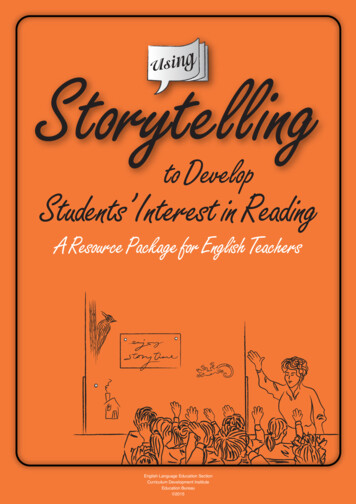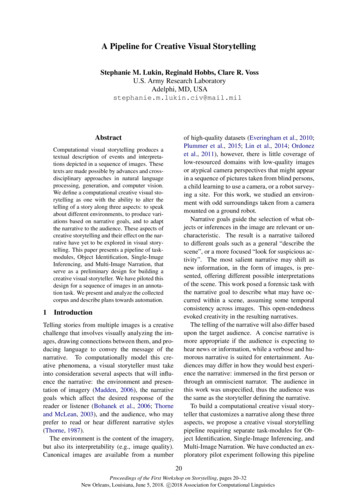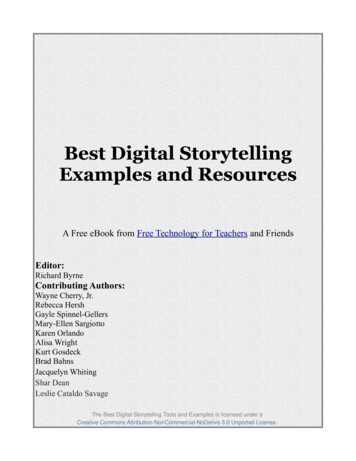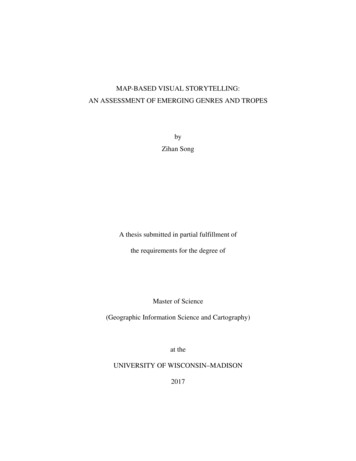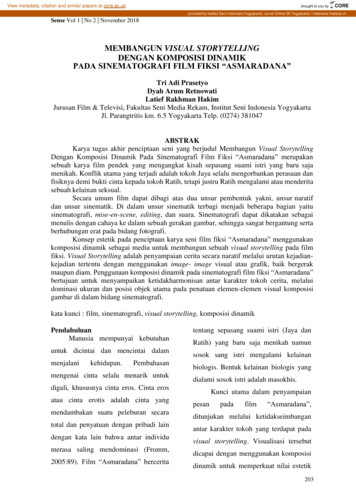
Transcription
Algorithms for StorytellingDeept Kumar , Naren Ramakrishnan , Richard F. Helm# , and Malcolm Potts# Department of Computer Science, Virginia Tech, VA 24061#Department of Biochemistry, Virginia Tech, VA 24061Contact: naren@cs.vt.eduAbstractWe formulate a new data mining problem called storytelling as a generalization of redescriptionmining. In traditional redescription mining, we are given a set of objects and a collection of subsetsdefined over these objects. The goal is to view the set system as a vocabulary and identify two expressionsin this vocabulary that induce the same set of objects. Storytelling, on the other hand, aims to explicitlyrelate object sets that are disjoint (and hence, maximally dissimilar) by finding a chain of (approximate)redescriptions between the sets. This problem finds applications in bioinformatics, for instance, wherethe biologist is trying to relate a set of genes expressed in one experiment to another set, implicated ina different pathway. We outline an efficient storytelling implementation that embeds the CARTwheelsredescription mining algorithm in an A* search procedure, using the former to supply next move operatorson search branches to the latter. This approach is practical and effective for mining large datasets and,at the same time, exploits the structure of partitions imposed by the given vocabulary. Three applicationcase studies are presented: a study of word overlaps in large English dictionaries, exploring connectionsbetween genesets in a bioinformatics dataset, and relating publications in the PubMed index of abstracts.Categories and Subject Descriptors: H.2.8 [Database Management]: Database Applications - DataMining; I.2.6 [Artificial Intelligence]: LearningGeneral Terms: Algorithms.Keywords: redescription, data mining, storytelling.1IntroductionRedescription mining is a recently introduced data mining problem [13, 14, 18] that seeks to find subsets ofdata that afford multiple definitions. The input to redescription mining is a set of objects and a collectionof subsets defined over these objects. The goal is to view the set system as a vocabulary of descriptors andidentify clusters of objects that can be defined in at least two ways using this vocabulary.For instance, consider the set system in Fig. 1 where the six objects are books and the descriptors denotebooks about traveling in London (Y), books containing information about places where popes are interred(G), popular books about the history of codes and ciphers (R), books about Mary Magdalene (M), and booksabout the ancient Priory of Sion (B). An example redescription for this dataset is: ‘books involving Prioryof Sion as well as Mary Magdalene are the same as non-travel books describing where popes are interred,’or B M G Y . This is an exact redescription and gives two different ways of defining the singletonset {‘The Da Vinci Code’}. The basic premise of redescription mining is that object sets that can indeedbe defined in at least two ways are likely to exhibit concerted behavior and are, hence, interesting. Thisproblem is non-trivial because we are given neither the object sets to be redescribed nor the set-theoreticconstructions to be used in combining the given descriptors.While traditional redescription mining is focused on finding object sets that are similar, storytelling aimsto explicitly relate object sets that are disjoint (and hence, maximally dissimilar). Given a start and enddescriptor, the goal here is to find a path from one to the other through a sequence of intermediaries, each1
YLondonMap GuideRick Steves’LondonGDa Vinci CodeCodebreakersBHoly BloodHoly GrailRChristianity’sHidden GoddessMFigure 1: An example input to storytelling.of which is an approximate redescription of its neighbor(s). An example story in the above dataset resultswhen we try to relate London travel books to books about codes and cipher history: Some London travelbooks (Y) overlap with books about places where popes are interred (G), some of which are books aboutancient codes (R). This story is a sequence of (approximate) redescriptions: Y G R. Each step ofthis story holds with Jaccard’s coefficient 1/3 (the ratio of the size of common elements to elements oneither side of the redescription). A stronger story, that holds with Jaccard’s coefficient 1/2 at each step, is:B (G M ) R.Why is this problem interesting and relevant? Storytelling finds application in many domains, suchas bioinformatics, computational linguistics, document modeling, social network analysis, and counterterrorism. In these contexts, stories reveal multiple forms of insights. First, since intermediaries mustconform to a priori knowledge, we can think of storytelling as a carefully argued process of removing andadding participants, not unlike a real story. Knowing exactly which objects must be displaced, and inwhat order, helps expose the mechanics of complex relationships. Second, storytelling can be viewed as anabstraction of relationship navigation for propositional vocabularies and offers insights similar to what weexpect to gain from techniques such as inductive logic programming applied to multi-relational databases.Third, storytelling reveals insight into how the underlying Venn diagram of sets is organized, and how itcan be harnessed for explaining disjoint connections. In particular, we can investigate if certain sets havegreater propensity for participating in some stories more than others. Such insights have great explanatorypower and help formulate hypotheses for situating new data in the context of well-understood processes.Finally, in domains such as bioinformatics, the emergence of high-throughput data acquisition systems (e.g.,genome-wide functional screens, microarrays, RNAi assays) has made it easy for a domain scientist to definevocabularies and sets. We argue that these domains are now suffering from ‘descriptor overload’; storytellingpromises to be a valuable tool to attack this problem and reconcile disparate vocabularies.Why is this problem difficult? Storytelling is non-trivial because the space of possible descriptor expressions is not enumerable beforehand and hence the network of overlap relationships cannot be materializedstatically. In a typical application, we have hundreds to thousands of objects and an order of magnitudegreater descriptors, with an even larger number of possible set-theoretic constructions made of the descriptors.Effective storytelling solutions must multiplex the task of constructive induction of descriptor expressionswith focused search toward the end point of the story.The main contributions of this paper are the introduction of the storytelling problem, its formalizationas a generalization of redescription mining, and an efficient storytelling implementation that embeds theCARTwheels redescription mining algorithm [14] in an A* search procedure. We also showcase three applications of storytelling: a study of word overlaps in large English dictionaries, exploring connections betweengenesets in a bioinformatics dataset, and relating publications in the PubMed index of abstracts. All theseapplications reveal insight into the underlying vocabularies and present significant potential for knowledgediscovery.2
S1S2S3S4S5S6 {{{{{{o1 ,o1 ,o2 ,o2 ,o3o4o3 ,o5o5o6}}}}}}Figure 2: Example data for illustrating operation of storytelling algorithm.2BackgroundThe inputs to storytelling are the universal set of objects O (e.g., books, genes) and a collection S of subsetsof O. The elements of S are referred to as the descriptors Si , and assumed to form a covering of O, i.e.,Si Si O. In addition, two elements of S are designated as the starting descriptor (X) and the endingdescriptor (Y ), where typically X Y φ. In the simplest version of storytelling, we must formulate asequence of descriptors (called a story) Z1 , Z2 , · · · , Zk S where Z1 X, Zk Y , and J (Zi , Zj ) θ,1 i k, j i 1, θ being a user supplied threshold. Here, J denotes the Jaccard’s coefficient between Z Z two sets, given by: J (Zi , Zj ) Zii Zjj . J is zero if the sets are disjoint, is one if they are the same, andis between zero and one if either descriptor is a subset of the other, or when they are overlapping. Everysuccessive pair of descriptors in the story constitutes a redescription, Zi Zj , whose left and right sides(approximately) induce the same subset of O. Observe that storytelling can progress only when redescriptionsare strictly approximate, i.e., when 0 J (Zi , Zj ) 1.In the generalized version of storytelling studied here, the intermediaries Zi are not constrained to be justelements of S but can be set-theoretic expressions made up of the Si ’s, e.g., S1 S3 , S2 S4 , S1 (S2 S5 ).In this case, to ensure well posedness, we will require that all participating expressions conform to a givenbias, e.g., monotone forms, conjunctions, or are otherwise length-limited.There are many algorithms proposed for mining redescriptions, some based on systematic enumerationand pruning (e.g., CHARM-L [18]) and some based on heuristic search (e.g., CARTwheels [14]). Thesealgorithms also differ in their choice of bias (conjunctions in CHARM-L, and depth-limited DNF expressionsin CARTwheels). We focus on CARTwheels as it provides the exploratory features necessary to incrementallyconstruct stories.CARTwheels exploits the fact that redescriptions never occur in isolation but rather in pairs or othergroups. For instance, redescription Zi Zj coexists with Zi Zj . This property is used to searchfor matching partitions (here, {Zi , Zi } and {Zj , Zj }) by growing two binary decision trees (CARTs) inopposite directions so that they are matched at the leaves. The nodes in these trees correspond to booleanmembership variables of the given descriptors so that we can interpret paths to represent set intersections,differences, or complements; unions of paths would correspond to disjunctions. Essentially, one tree exposesa partition of objects via its choice of descriptors (e.g., Zi ) and the other tree tries to grow to match thispartition using a different choice of descriptors (Zj ). If partition correspondence is established, then pathsthat join define redescriptions. CARTwheels explores the space of possible tree matchings via an alternationprocess whereby trees are repeatedly re-grown to match the partitions exposed by the other tree.Unlike previous work, where CARTwheels alternation was configured to enumeratively explore the spaceof all redescriptions [14], the main contribution of the present paper is to demonstrate how we can focus thealternation toward a target descriptor.3Designing a StorytellerWe embed CARTwheels inside an A* search procedure, using the former to supply next move operators onsearch branches to the latter. Each move is a possible redescription to be explored and a heuristic functionevaluates these redescriptions for their potential to lead to the end descriptor of the story. In this paper,3
obj.o1o2o3o4o5o6S2 S3 S4 S5 S6 obj.o1o2o3o4o5o6classS1S1S1S1S1S1S1 S3 S4 S5 S6 class(S2 S3 )(S2 S3 )(S2 S3 )(S2 S3 )(S2 S3 )(S2 S3 )Figure 3: (left) Dataset to initialize storytelling algorithm. (right) Dataset for the second iteration.we focus on story length—number of redescriptions to reach the end descriptor—as the primary criterion ofoptimality although different criteria might be more suitable in other applications. Backtracking happenswhen a previously unexplored move (redescription) appears more attractive than the current descriptor. Thesearch terminates when we reach a descriptor that is within the specified Jaccard’s threshold from the endingdescriptor or when there are no redescriptions left to explore.3.1Working ExampleFor ease of illustration, consider the artificial example in Fig. 2 with six descriptors {S1 , S2 , S3 , S4 , S5 , S6 }defined over the universal set O {o1 , o2 , o3 , o4 , o5 , o6 } (in a realistic application, the number of descriptorswould greatly exceed the number of objects). Our goal is to find a story between descriptor S1 , correspondingto the set {o1 }, and S5 , corresponding to the set {o5 }, such that each step is a redescription that holds withJaccard’s coefficient at least θ 0.5. In this example, we set the maximum depth of decision trees used to2.To initialize the alternation, we prepare a traditional dataset for classification tree induction (see Fig. 3,left), where the entries correspond to the objects, the class (to be learnt) corresponds to the starting descriptor, and the boolean features are comprised of the remaining descriptors. A classification tree can nowbe grown using these features and class assignments, using the Jaccard’s coefficient as the node evaluationcriterion. Hence, at each level in the decision tree we construct, we look for a descriptor Si such that one ofthe blocks in its induced partition will provide the best overlap with the class we seek (in this case, S1 ). If themaximum Jaccard’s coefficient value obtainable is lesser than θ, we choose the descriptor that provides thebest value. Else, we consider all descriptors that satisfy the Jaccard’s threshold and, among them, greedilychoose the one with the highest Jaccard’s coefficient with the end point of the story. The tree growth iscontinued until the maximum Jaccard’s coefficient observed at a given depth is lesser than that observedat the parent level, or the depth limit of tree growth is reached. Once the tree has been constructed, classassignments at the leaves are made by majority and paths that lead to a given class are union-ed to formredescriptions.For instance, Fig. 4 (a) shows the decision tree we have constructed to match the partition {S1 , S1 }. Thistree provides the first step in the story to be the redescription S1 (S2 S3 ). In this example, we show onlyone possible ‘next tree’ for our example but in our implementation, we maintain a number of such possiblematching trees, to simulate a branching process and for potential backtracking. Note that while the currentredescription holds with a Jaccard’s value of 0.5, the new descriptor does not have any overlap with S5 .For the next step in our story, we use the partition {(S2 S3 ), (S2 S3 )} as the classes to match andconsider the dataset as shown in Fig. 3 (right). In constructing the new dataset, observe that we ignorethe descriptor that is the top-most node (here, S2 ) in the decision tree that defines the current partition.This ensures that we do not utilize the same features for matching a partition as those that define thepartition! The one-level tree we learn at this stage is shown in Fig. 4 (b). The redescription of interest hereis (S2 S3 ) S3 , which also holds with a Jaccard’s coefficient of 0.5. Although it introduces the element weseek (o5 ), the redescription to the end point of the story, S3 S5 , has only a Jaccard’s coefficient of 0.25.We hence continue the search and obtain the redescription S3 S4 which gives us the desired overlap withthe target, and our final redescription, namely S4 S5 . Our story is thus S1 (S2 S3 ) S3 S4 S5 .4
noyesyesnonoS1S3S3S5(a)(b)(c)(d)Figure 4: Storytelling using CARTwheels alternation. Beginning with S1 , the starting descriptor exposedby the bottom tree in (a), the alternation systematically moves toward S5 , the ending descriptor in (d). Ateach step we alternately keep one of the trees fixed and grow a new tree to match it. The story mined hereis the sequence of redescriptions: S1 (S2 S3 ) S3 S4 S5 .3.2ImplementationThe storytelling algorithmic framework is shown in Table 1 and follows the outline of the working exampleabove. The key utility functions are: construct dataset, that prepares the dataset D at each alternation;construct tree, that is called b (branching factor) times at each step to create trees of desired depth limit d;eval, which determines if the Jaccard’s coefficient between the current descriptor and the union of the pathsleading to it in the current tree have a Jaccard’s coefficient higher than or equal to θ; calculate heuristic score,which computes the heuristic score for each tree; and print story, which prints the story by tracing back thesequence of mined redescriptions.In the outer A* search procedure, qualified trees are placed in the open list OL (a priority queue) andconsidered in order of their evaluations. If the heuristic evaluation hN for the currently picked tree tN iszero, we have arrived at a tree that has sufficient Jaccard’s overlap with the end point of the story andwe terminate. If hN is not zero, a new set of classes C for objects in O are induced using the functionpaths to classes, tN is moved to the closed list, and all trees induced by construct tree are placed in the openlist. This process is repeated until there is no tree left in the open list or a story has been found.Just as the notion of ‘class’ is revised periodically at each alternation, so are the candidate set of ‘features.’Observe that, in the Initialization step, the set of possible features involves all except the starting descriptor.Inside the Alternation subroutine, the candidate set of features is made equal to all except the feature usedat the root of the current tree (supplied by the routine top).The heuristic score hj for tree tj is combined with cost expended so far (gj ) to arrive at the evaluationcriterion sj . Nodes in OL are hence ordered by sj . We assume unit cost per redescription so that the storylength is the number of redescriptions required to traverse to the ending descriptor. The heuristic functionh is designed to systematically never over-estimate the number of redescriptions remaining and takes thevalue of zero for a tree whose partition is within the specified Jaccard’s coefficient to the ending descriptor.We now present details of h and prove its admissibility.Table 2 outlines the approach to estimate hj for tree tj . This algorithm can be understood as follows.Assume that the new descriptor Zj (provided by tree tj ) has f elements in common with the target descriptorY and e elements that do not participate in Y . This means that Zj must shed enough of the e elements andacquire enough of the Y f elements in order to have a Jaccard’s threshold of θ with Y . The goal of5
calculate heuristic score is to estimate the number of redescriptions required to shed the requisite numberamong e elements and acquire some of the necessary Y f elements. The procedure first conservativelyestimates if the current discrepancies already correspond to a Jaccard’s threshold of θ with Y , in whichcase it returns zero. If this is not possible, the procedure estimates the shortest number of steps in whichthe deletions and additions can happen by a recursive computation. Two extremes are considered at eachstep – the case where we can acquire as many of the necessary new elements as dictated by θ without anyremovals, and the case where we can shed as many of the unnecessary elements as dictated by θ without anyadditions. This step provides us the bounds δfmax and δemax in Table 2. We then search combinatoriallywithin these ranges for the maximal number of deletions, for every possible number of additions, such thatθ holds, akin to dynamic programming. The minimum number of redescriptions over all possibilities is thenreturned. It is easy to see thatLemma 1 The heuristic defined by calculate heuristic score is admissible.3.3Data structuresThe efficient implementation of our storytelling algorithm hinges on data structures for fast estimation ofoverlaps. This problem has been studied by the database community in various guises, e.g., similaritysearch [11] and set joins on similarity predicates [15]. Specific solutions advocate the use of signaturetrees [7], hierarchical bitmap indices [10], and locality sensitive hashing [4], especially the technique of minwise independent permutations [2] that is particularly geared toward the Jaccard’s coefficient. In this paper,we combine an AD-tree data structure [9] with the signature tables [1] approach for efficient similarity searchin categorical data.The signature table is constructed before the Initialization step mentioned in Table 1. Here, objects inthe universal set are divided into a predefined number of clusters (c) on the basis of their co-occurrencefrequencies. This is achieved by first constructing a graph where each object is a node and objects that cooccur form edges. Each edge is associated with a weight which is the inverse of the co-occurrence frequencyfor that edge. The weight associated with each node is the sum of the weights of each edge it is a part of.The total weight of the graph is the sum of the weight of all nodes. We set the critical weight of the graph tobe the total weight divided by c. For finding each cluster, we begin with the nodes that are a part of the edgethat currently has the minimum weight associated with it. We delete these nodes from the graph and addthem to the current cluster. The weight of the cluster is now the sum of the weights of nodes it contains (asobtained from the original graph). We continue to add nodes to the cluster that have the minimum weightin an edge associated with any of the objects that already are a part of the cluster. This continues till theweight of the cluster is greater than the critical weight. At this point, we recalculate the critical weight onthe basis of the nodes remaining in the original graph and proceed to finding the next set of nodes, till all cclusters have been found.Each descriptor, originally a binary vector size O , can now be condensed into a binary vector (thesignature) of size c by encoding a 1 for each cluster that has an object present in the descriptor and a 0 foreach cluster that has no object in the descriptor.All descriptors and their co-occurrence frequencies (used in constructing a decision tree of depth morethan 1) are also built into an AD-tree at this stage. The descriptors at the top-level of the AD-tree areadditionally linked to their signatures. When a similarity search query is issued, only nodes that correspondto signatures of interest need to be investigated. At greater depths in the AD-tree, we can either constructindividual signature tables for each node in the AD-tree or we can opt to use a traditional AD-tree nodethat contain descriptor names and co-occurrence frequencies. In our implementation, we used traditionalAD-tree nodes at depth greater than 1.Using these data structures, we can reduce the number of descriptors searched against at each step andimprove the speed of computation of stories. For instance, in the first call to the function construct tree,where we are looking for the best match for the class X from among the descriptor set D, we can reduce Xto a vector of size c (X c ). Also, we keep a count of the number of objects in X that belong to each of the c6
proteinmodificationYGL158WYJL164CYKL035Wcell WYJL164CYCL040WYDR516CYFR053CFigure 5: A significant story among gene sets from protein modification to hexokinase.clusters in the form of a frequency vector f c . The optimistic Jaccard’s coefficient (OJ ) between X c and asignature vector Vic corresponding to a set of descriptors can then be calculated by the formulaPccccj 1 (f [j] X [j] Vi [j])ccPcOJ (X , Vi ) cj 1 f [j]We then compare X c to all the signature vectors and retain only those for which the optimistic Jaccard’scoefficient is above θ. This narrows down our search to only those descriptors that have potential to providethe necessary overlap.3.4Assessing Significance of StoriesThe significance of a story is assessed at the level of each redescription participating in the story. To assessthe significance of redescription X Y , we use the cumulative hypergeometric distribution to determine theprobability of obtaining a rate of co-occurrence of X and Y (over the object domain), given their marginaloccurrence probabilities, and comparing it to the observed rate of co-occurrence by chance. To account formultiple hypothesis testing, the significance threshold is determined by first characterizing the distributionfor all descriptors tested and determining if the given redescription has a rate of occurrence more than fourstandard deviations above the mean.4Experimental ResultsOur three experimental studies are meant to illustrate different aspects of our storytelling algorithm andimplementation. The first study characterizes word overlaps in large English dictionaries and illustratesscalability of the implementation and how the different parameter settings affect the quality of stories mined.The second study, involving gene sets in bioinformatics, showcases the constructive induction capabilities ofCARTwheels when used for storytelling. This study and the third, which builds stories between PubMedabstracts, also illustrate interesting nuggets of discovered knowledge.4.1Word OverlapsIn our first study, we implement storytelling for the MorphWord puzzle wherein we are given two words,e.g., PURE and WOOL, and we must morph one into the other by changing only one letter at a time(meaningfully). One solution is: PURE PORE POLE POLL POOL WOOL. Here we canthink of a word as a set of (letter, position) tuples so that all meaningful English words constitute thedescriptors. Each step of this story is an approximate redescription between two four-element sets, havingthree elements in common. It is important to note that words that are anagrams of each other (e.g., ‘ELVIS’and ‘LIVES’) will not have a Jaccard’s coefficient of 1, since position is important.We harvested words of length 3 to 13 words from the Wordox dictionary of English words (http://www.esclub.gr/games/wordox/), yielding more than 160, 000 words. Consistent with the MorphWord puzzle, we7
Early expression of yeast genesaffected by chemical stress(PMID:15713640; 2005–02–16) Glutathione, but not transcription factorYap1, is required for carbon source-dependentresistance to oxidative stress inSaccharomyces cerevisiae(PMID:10794174; 2000–06–22) The role of glutathione inyeast dehydration tolerance(PMID:14697735; 2003–12–30) The adaptive response ofSaccharomyces cerevisiaeto mercury exposure(PMID:11816031; 2002–01–29) Cloning, characterization, andexpression of the CIP2 gene inducedunder cadmium stress in Candida sp.(PMID:9627968; 1998–07–09) Mutations in the Schizosaccharomyces pombeheat shock factor that differentially affectresponses to heat and cadmium stress(PMID:10071222; 1999–04–07) Genome-wide analysis ofthe biology of stress responsesthrough heat shock transcription factor(PMID:15169889; 2004–05–31) Isolation and characterization ofHsfA3, a new heat stress transcriptionfactor of Lycopersicon peruvianum(PMID:10849352; 2000–10–10) Heat stress transcription factorsfrom tomato can functionally replaceHSF1 in the yeast Saccharomyces cerevisiae(PMID:9268023; 1997-09-18)Figure 6: An example significant story among PubMed abstracts relating chemical stresses.8
restrict all CARTs to be of depth d 1 and study the effect of θ and b on the number of stories possible,length of stories mined, and time taken to mine stories. For ease of interpretation, we recast Jaccard’sthresholds in terms of the number of letters in common (lc) between two words. Although MorphWord istraditionally formulated with lc 1, we explore higher lc values as well. Due to space restrictions, we presentour results on subsets of the master word list, namely 5 letter words (L5 ) and 10 letter words (L10 ). In eachcase, we selected 100, 000 pairs of words at random and tried to find stories between them, with differentlc and b settings. An example story we mined with five letter words (with setting lc 3) is: BOOTH BOATS BEAMS DEADS GRADS GRADE CRAZE CRASH FLASH.Fig. 7 (first column) depicts plots of the fraction of stories (out of 100, 000) mined with various storylengths as a function of lc, for a branching factor b 5. In these plots, a story length of 0, rather counterintuitively, implies that no story was found for the word pair considered. The critical story length where themajority of stories are mined steadily increases as lc is increased. This is because, as lc is increased, moreoverlap is required at each step of the story such that it takes longer for one word to morph into another.At the same time, the total number of stories mined decreases as lc is increased, due to the lack of viableredescriptions.To study the effect of b on the length of stories mined, we focus our attention on lc values of 2 for L5 and5 for L10 . Fig. 8 (first column) shows plots of the fraction of stories mined with various lengths as a functionof b. As before, a path length of 0 in the plots implies that no story was found for the word pair considered.Here, there are qualitative changes between the two datasets (Fig. 8, first column, top and bottom rows).For L5 , the lc value chosen (2) supports a significant number of short stories. This lc value affords ahigh number of possible redescriptions per descriptor (about 20–100), making it highly likely that the A*algorithm will follow a path that leads close to the target word. In other words, b does not have as significantan impact for this dataset.For L10 , the lc value chosen contributes to a higher probability of longer stories. As a result the branchingfactor b plays a crucial role. This is evident in the case of b 1, where the excessively greedy strategy isoften rendered futile. As b increases, the chances of going down toward the target word increases and morestories are mined.To study the effect of these parameters on
Algorithms for Storytelling . books about traveling in London (Y), books containing information about places where popes are interred (G), popular books about the history of codes and ciphers (R), books about Mary Magdalene (M), and books about the ancient Priory of Sion (B). An example redescription for
